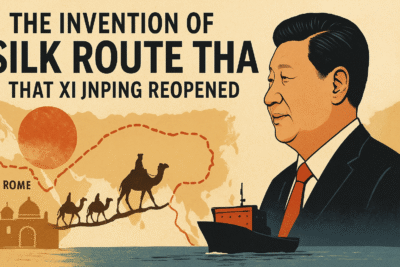
In the quiet village of Kintoor in Barabanki district, Uttar Pradesh, India, lies the starting point of a remarkable ancestral journey that would eventually shape the leadership of modern Iran. This is the forgotten Indian origin of Ayatollah Ali Khamenei, Iran’s Supreme Leader, whose family history bridges centuries, cultures, and continents.
Multiple Indian news outlets have reported about this link. But they have not corroborated it with the official version of the lineage shared by the Iranian government. This is why this post is here.
The Indian origin: Syed Ahmad Musavi Hindi
The story begins with Syed Ahmad Musavi, born in 1790 in Kintoor, Barabanki. A respected Shia scholar, Syed Ahmad embarked on a religious pilgrimage in the early 1830s, joining the entourage of the Nawab of Awadh — most likely Nasir-ud-Din Haidar Shah (ruler from 1827 to 1837) — to the holy Shia sites in Najaf, Iraq.
During this journey, Syed Ahmad befriended a prominent local cleric, Yousef Khan Kamarchi of Farahan, a region in Iran known for its religious scholarship. This friendship proved pivotal. Syed Ahmad married Yousef Khan Kamarchi’s sister, Sanikeh, cementing a familial and scholarly alliance that would anchor his family in Iranian soil.
Following the pilgrimage, Syed Ahmad settled initially in Najaf, a centre of Shia learning in Iraq, before moving to the town of Khomein in Iran around 1834. To honour his Indian origins, he adopted the surname “Hindi”, a marker of his heritage that persists in historical records.
Establishing roots in Iran
Syed Ahmad Musavi Hindi’s marriage to Sanikeh symbolised the blending of Indian and Iranian Shia scholarly traditions. This union laid the foundation for a distinguished clerical lineage that would rise to prominence in Iran’s religious and political spheres.
Their descendants continued the family’s scholarly legacy:
- Ruhollah Musavi Khomeini (1902–1989), Syed Ahmad’s grandson, emerged as the leader of the 1979 Islamic Revolution, founding the Islamic Republic of Iran.
- Ayatollah Khamenei’s father, Sayyid Javad Khamenei, was born in Najaf and married Khadijeh Mirdamadi from Yazd, Iran, further intertwining regional religious lineages.
- Ali Khamenei was born in 1939 in Mashhad, Iran, as the second of eight children, raised in a deeply religious environment shaped by his family’s scholarly traditions.
In all probability, Ahmad Musavi Hindi’s grandson was the first to add Khomenei to the family name dropping Hindi, which revealed the migrant family’s foreign origin to their contemporaries. To assert their local connection, “Khomenei” roots was sown afresh, cutting ties from India’s Uttar Pradesh.
Iran’s incumbent Grand Ayatollah (chief cleric) changed it from Khomenei to Khamenei.
This apparent desire to appear more Iranian than the local Persian people, the Khomeneis created an agitation that turned into a revolution — the Islamic Revolution, because the family occupation has been that of a cleric for generations. To reassert the authenticity of their firmans and decrees, the family also emphatically claims ancestry to Prophet Muhammad’s son-in-law Imam Ali.
Curiously, when Khomenei toppled the Shah dynasty of Persia, as Iran was known till 1979, he chose a name from a word that’s rooted in India — Iran. The root word from where Iran comes is the same as Arya or Aryan. The genetic pull of the Khomeneis might have been a factor in the rechristening of Persia as Iran.
By the way, on a lighter note, Uttar Pradesh, the land of numerous Indian pilgrim sites, can also claim to have produced men who laid the foundation of at least three Islamic nations — Pakistan, thereby Bangladesh, and Iran.
The wide angle view
The migration of Syed Ahmad Musavi Hindi was part of a wider movement of Shia scholars from the Indian subcontinent to the religious centres of Najaf and Qom, driven by the pursuit of theological learning and religious authority. The Nawabs of Awadh patronised such pilgrimages, reinforcing the cultural and spiritual ties between Awadh’s Shia community and the heartlands of Shia Islam.
The marriage between Syed Ahmad and Sanikeh was one of the outcomes of such fusions of Indian and Iranian Shia traditions that resonate in Tehran and beyond.



